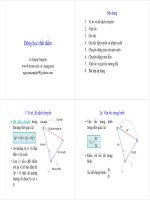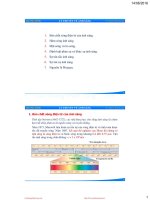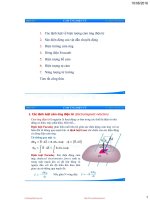- Trang chủ >>
- Khoa Học Tự Nhiên >>
- Vật lý
Bài giảng vật lý 1
Bạn đang xem bản rút gọn của tài liệu. Xem và tải ngay bản đầy đủ của tài liệu tại đây (4.73 MB, 183 trang )
ĐẠI HỌC ĐÀ NẴNG
TRƯỜNG ĐH SƯ PHẠM
KHOA VẬT LÝ
VẬT LÍ 1 CLC:
PHYSICS 1: MECHANICS AND THERMODYNAMICS
PHYSICS 2: ELECTRICITY AND MAGNETISM, OPTICS AND
MODERN PHYSICS
DỤNG VĂN LỮ
• ĐT: 0935 117 206; Email:
• CV: />
1
Online reference
• 1. Dictionary: (physics) ;
(life) />(Sharing reading En) />• 2. Physics:
+ Animate:
+ Physical terms: />+ Lecture MIT:
/>NP_xHpGV89
+ Search: or />+ ...
2
New words – 1.1; Physics/ˈfɪzɪks/
1. Concept (n) /ˈkɒnsept/ an idea or a principle that is connected with something
abstract: khái niệm; Ex. Basic concepts of Mechanics...
2. Law (n) /lɔː/ a scientific rule that somebody has stated to explain a natural
process: định luật; Ex. Newton’s second law...
3. Mechanics (n)/məˈkænɪks/ the science of movement and force: cơ học;
4. Mechanic (n) /məˈkænɪk/ a person whose job is repairing machines, especially
the engines of vehicles. Ex. a car/motor mechanic
5. Property (n) /ˈprɒpəti/ a quality or characteristic that something has: tính
chất. Ex. Properties of motion
6. Motion (n) /ˈməʊʃn/ the act or process of moving or the way something moves:
sự chuyển động
7. Particle (n) /ˈpɑːtɪkl/ a very small piece of something: hạt/chất điểm
8. Rigid (adj)/ˈrɪdʒɪd/stiff and difficult to move or bend:cứng,rắn; Ex.Rigid object
New words – 1.2
9. Position (n) /pəˈzɪʃn/ the place where somebody/something is located: vị trí
10. Speed (n) /spiːd/ the rate at which somebody/something moves or travels:
tốc độ
11. Velocity (n) /vəˈlɒsəti/ the speed of something in a particular direction: vận
tốc. Ex. Angular velocity, velocity component...
12. Acceleration (n) /əkˌseləˈreɪʃn/ the rate at which the velocity (= speed in a
particular direction) of an object changes: gia tốc
13. Linear (adj) /ˈlɪniə(r)/ able to be represented by a straight line on a graph:
tuyến tính/thẳng
14. Momentum (n) /məˈmentəm/ /məʊˈmentəm/ the quantity of movement of
a moving object, measured as its mass multiplied by its speed: động lượng
15. Work (n) /wɜːk/ the use of force to produce movement: công. Ex. Work done
by gravitational force
16. Principle (n) /ˈprɪnsəpl/ a general or scientific law that explains how
something works or why something happens: nguyên lý, định luật
Syllabus – Đề cương Học phần
1. Title: Physics 1
2. Credits: 3
3. Prerequisites:
Analytics analysis
4. Course Description
This course tends to give students opportunity to explore the basic concepts,
laws and application of Mechanics and Thermodynamics, including:
Properties and laws of motion of particle, rigid body
Relationship among position, velocity and acceleration
Laws of linear momentum, angular momentum and energy
The kinetic theory of gases, thermodynamic quantities
Laws of Thermodynamics
Syllabus – Đề cương Học phần
5. Textbook
1. Trần Ngọc Hợi, Phạm Văn Thiều. Vật lý Đại cương: Các nguyên lí và ứng
dụng, Tập 1: Cơ & Nhiệt, NXB Giáo dục 2006. (~Lương Duyên Bình)
2. Raymond A. Serway and W. Jewett, Physics for Scientists and Engineers
with Modern Physics (9th Edition), Cengage Learning, USA, 2014
3. Tập Bài giảng&BT Vật lý 1 CLC (do GV biên soạn)
Reference Books
1. Giancoli D.C. Physics Principles with Applications, 7th ed.
2. Paul A. Tipler and Gene Mosca, Physics for Scientists and Engineers (6th
Ed.), W. H. Freeman and Company, USA, 2008
3. David Halliday, Fundamentals of Physics, T.1&2, John W&S. 2005.
Syllabus – Đề cương Học phần
• 6. Lesson plan (4hours/week)
Week
Lesson
Preparation of student
Introduction
1
Chapter 1: Introduction to Physics
Chapter 2: Motion in one dimension
Read the text book: 2-13
Read the text book: 21-40
Chapter 2 (cont.)
Read the text book: 40-47
Chapter 3: Montion in two dimensions
Read the text book: 111-135
3
Solve problems of chapters 3, 4
Prepare the solution
4
Chapter 4: The laws of motion
Chapter 5: Work&Energy of the system
Read the text book: 140-201
5
Chapter 5: (Cont.)
Chapter 6: Linear Momentum and Motion of System
Read the text book: 247-279
6
Solve problems of chapters 4&5
Prepare the solution
2
Syllabus – Đề cương Học phần
• 6. Lesson plan (4hours/week)
Week
Lesson
Preparation of student
7
Chapter 6: (Cont.)
Chapter 7: Rotation of rigid object about a fiexd axis. Angular
momentum
Read the text book 293352
8
Mid-term Test
Prepare Ch. 2-5
9
Chapter 7: (cont.)
Read the text book: 568Chapter 8: Tempurature and the first law of Thermodynamics 625
10
Solve problems of chapters 6&7
Prepare problems
11
Reporting Projects
Presenting
12
Chapter 8 (Cont.)
Chapter 9: The kinetic theory of gases
Chapter 10: The 2law of Thermod.
Read the text book: 626688
13
Solve problems of chapters 8-10
Prepare Problems
Syllabus – Đề cương Học phần
7. Assessment
Assessment Types
A1. Learning
activities
A2. Midterm Exam
A3. Final Exam
Assessment Components
A1.1. Attendance/Discuss: ~5%
A1.2. Homework report: ~15%
A1.3. Project:
~ 10%
A2.1. Written Test
(có thể thi chung)
Percentages
0.3 =30%
0.2 =20%
A3.1. Written Test
0.5 = 50%
(thi chung, đề chung, chầm chung, rọc phách)
Luôn luôn sẵn sàng hổ trợ về kiến thức, kĩ năng.
NHƯNG: Vui lịng: KHƠNG XIN, KHƠNG NHỜ về điểm...
10
7. A1. Learning activities; 40+=10 điểm
Trình bày báo cáo nhóm tối đa: 12+
Nộp bài tập tất cả các chương trước GK tối đa : 6+
Nộp bài tập tất cả các chương trước CK tối đa : 6+
Trình bày bt trên bảng theo phân công tối đa : 4+
Nộp 1 bài tập được phân công tối đa : 2+
2 lần kiểm tra 15’ cuối chương 4 và cuối chương 7: 2x3đ= tối đa 6+
Phát biểu/thảo luận trong tiết lí thuyết/bài tập: (1-2)+/lần
Điểm danh bằng cách gọi tên hoặc nộp bài tập nhỏ theo yc GV: Vắng 1
buổi: trừ 4-.
* Các mục trên đều có tham gia và tích lũy đủ 40+= 10 điểm trong cột điểm
BT (0.3).
-
Project (làm dự án): Max-12+
• Cách thức tổ chức:
- Mỗi lớp chia thành nhóm nhỏ (gồm 5 đến 6sv), có nhóm trưởng và thư ký .
- Mỗi nhóm phải chọn 1 chủ đề dự án trong nhóm dự án đề xuất. Khuyến
khích lựa chọn dự án theo ngành SV đang theo học.
- Trong bài báo cáo Powerpoint: tên dự án, tên thành viên, CDIO là gì?,
ngun lí vật lí của mơ hình, phải chụp hình các thành viên tham gia trong
lúc làm việc, các minh chứng các giai đoạn trên). KHÔNG GÁNH TEAM!
- Dự án 1: Chế tạo động cơ nhiệt (đ/c đốt ngoài Stingler)
- Dự án 2: Chế tạo bàn xếp như hình
- Dự án 3: ... (SV có thể đề xuất)
- Xem thêm thông tin ở file dự án project gửi cùng bài giảng, bài tập
Syllabus – Đề cương Học phần
8. Student Responsibilities and Policies:
Attendance: It is compulsory that students attend at least 80% of
the course to be eligible for the final examination.
Missed tests: Students are not allowed to miss any of the tests.
There are very few exceptions.
VẮNG THI GK/CK => 0 điểm
KHÔNG gian lận (tài liệu, Điện thoại, trao đổi...) trong thi cử
16
What are DIFFIRENCES between
School & University
School a place where children go to be educated; ‘leisure,
philosophy, lecture-place
University an institution at the highest level of education where
you can study for a degree or do research; ‘the whole’,
’universus ‘, combined into ‘one, whole’,
17
What are DIFFIRENCES between
School & University
1. Kiến thức (đa dạng, phức tạp...)
2. Cường độ học tập
3. Lớp học đông hơn
4. Tự do hơn
5. TỰ HỌC – Self-sutdy
Xxx ....
Email gửi tài liệu
PART 1: MECHANICS
Introduction to Physics and
Mechanics
CHAPTER 1
1.1. Giới thiệu về vật lý, cơ học; Thứ nguyên, đơn vị SI
Physics, the most fundamental physical science, is concerned with the
fundamental principles of the Universe.
The study of physics can be divided into six main areas:
Classical mechanics:/ˈklæsɪkl məˈkænɪk/ concerning the motion of objects that
are large relative to atoms and move at speeds much slower than the speed of light
Relativity: /ˌreləˈtɪvəti/ a theory describing objects moving at any speed, even
speeds approaching the speed of light
Thermodynamics: /ˌthɜːməʊdaɪˈnæmɪks/ dealing with heat, work, temperature,
and the statistical behavior of systems with large numbers of particles
Electromagnetism: /ɪˌlektrəʊˈmæɡnətɪzəm/ electricity, magnetism, and EM fields
Optics: /ˈɒptɪks/ the study of the behavior of light and its interaction with
materials
Quantum mechanics: /ˌkwɒntəm məˈkænɪks/ a collection of theories connecting
the behavior of matter at the submicroscopic level to macroscopic observations
1.1. Giới thiệu về vật lý, cơ học; Thứ nguyên, đơn vị SI
Kinematics: describe the motion of an object while ignoring the
interactions with external agents
Dynamics: study forces and their effects on motion.
Motion in one dimension: motion of an object along a straight line
Particle model: describe the moving object as a particle regardless of
its size (a particle to be a point-like object)
Physical terms
/>motion, particle, kinematics, position, reference point, coordinate system,
velocity, speed, average/instantaneous velocity/speed, derivative,
acceleration, gravity, resistance, period, angular speed, centripetal
acceleration,
tangential
and
radial
acceleration,
relative
velocity/acceleration
1.1. Giới thiệu về vật lý, cơ học; Thứ nguyên, đơn vị SI
• In physics, the word dimension denotes the physical nature of
a quantity.
• The distance between two points, for example, can be measured in feet, meters, or
furlongs ..., which are all different ways of expressing the dimension of length.
• The dimensions: [l-length]=L, [m-mass]=M, [t-time]=T
• Example:
• The dimensions of speed 𝑣 = 𝑙/𝑡 are written [v ] = L/T.
• The dimensions of area 𝐴 = 𝑙 × 𝑙 are [A ] = L ì L = L2.
ã Find dimentionally correct formula: 𝑎c = 𝑣 𝑚 𝑅𝑛
• 54km/h=?m/s
1.1. Giới thiệu về vật lý, cơ học; Thứ nguyên, đơn vị SI
In 1960, an international committee established a set of standards for the fundamental
quantities of science call SI (Système International)
Length: The distance between two points in space; Standard in SI: meter (m)
• 1960: 1m = the length of the meter was defined as the distance between two lines on a
specific platinum–iridium bar stored under controlled conditions in France
• 11960s-1970s: 1m = 1 650 763.73 wavelengths 1 of orange-red light emitted from a
krypton-86 lamp
• 983: 1m = the distance traveled by light in vacuum during a time of 1/299792458 second
Mass: Standard in SI: kilogram (kg)
• 1987: 1kg = the mass of a specific platinum–iridium alloy cylinder kept at the
International Bureau of Weights and Measures at Sèvres, France
Time: Standard in SI: second (s)
• 1967: 1s = 9 192 631 770 times the period of vibration of radiation from the cesium-133
atom (in an atomic clock)
1.2. Các phép đo, sai số, chữ số có nghĩa
• Direct/Indirect Measurement
• Error/ uncertainty
• Significant Figures
(Read more in textbook of “Experiment of General Physics”)
Thí nghiệm VL A, B (tầng 2 Khu D)
1.2. Các phép đo, sai số, chữ số có nghĩa
Significant figures is the number of numerical digits used to express the measurement
+ 1; 2 have one significant figure; 12; 2,3 have two SF; 123; 1,56 have three SF.
+ 1.01; 202 have three SF; 2016; 50.25 have four SF; 30001; 1.1001 have five SF
+ 0.1; 0,002 have one SF; 0.16; 0,0025 have two SF; 0.102; 0.123 have three SF
+ 12.00; 2.010 have four SF; 20; 2.0 have two SF; 0.100; 10.0 have three SF
+ Mass of 1500 g is an ambiguous value → should use scientific notation such as 1.5 ×
103 g (2 SF), or 1.50 × 103 g (3 SF), or 1.500 × 103 g (4 SF)
+ The same rule holds for numbers less than 1. Ex: 2.3 × 10−5 (2 SF), 1.560 × 10−2 (4
SF)
1.3. Cách viết kết quả và bài tập áp dụng
The rule of determinating the number of significant figures
When multiplying several quantities, the number of significant figures in the final
answer is the same as the number of significant figures in the quantity having the
smallest number of significant figures. The same rule applies to division
Ex: Report the result of multiplications
The area of a carpet whose length is 15.24 m and whose width is 2.19 m
𝐴 = 15.24 × 2.19 = 33.4 m2
The area of the disc whose radius is 6.0 cm
33.3756
𝐴 = 𝜋6.02 = 1.1 × 102 cm2 (113.097 335 … )
1.3. Cách viết kết quả và bài tập áp dụng
The rule of determinating the number of significant figures
When numbers are added or subtracted, the number of decimal places in the result
should equal the smallest number of decimal places of any term in the sum or
difference
Ex: 23.5 + 6.174 = 29.7 (29.674)
Note:The rule for rounding number
The last digit retained is increased by 1 if the last digit dropped is greater than 5 (Ex:
2.567 → 2.57)
If the last digit dropped is less than 5, the last digit retained remains as it is (Ex:
2.564 → 2.56)
If the last digit dropped is equal to 5, the remaining digit should be rounded to the
nearest even number (Ex: 2.565 → 2.56, 2.555 → 2.56)
Review củng cố chapter 1
• *Các đơn vị chuẩn SI của: length (m), mass (kg), time (s)
• Chữ số có nghĩa và cách viết kết quả.









